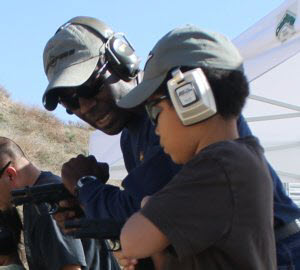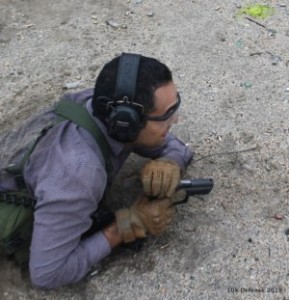Gross Motor Skills vs. Fine Motor Skills
Weapons manipulation skills in defensive shooting can prove to be a difficult task for new shooters. As a defensive shooting instructor, I strive to provide clients with techniques that can be performed in high-stress situations in a short amount of time.
In the context of defensive shooting, we are solely concerned with responding appropriately with our firearm to a situation that may require deadly force. Orienting our body toward the threat and extending the firearm parallel and within our line of sight can be considered gross motor skills. Touching and pressing the trigger smoothly to the rear is by definition a fine motor skill.

Shooters of all ages can benefit from learning how to use gross motor skills to manipulate a firearm.
For shooters with limited resources and time to train, weapons manipulation can be considered a “discrete task,” a task where performance levels decrease after a period of time with no use. Discrete tasks usually use fine motor skills, but in the case of firearms, you can modify some fine motor skills along with gross motor skills. By developing gross motor skills to manipulate your firearm, you can maintain an acceptable performance level in your firearms handling even with limited training time.
Pistol
Besides using the trigger, a shooter will find getting the pistol back into battery a common task. Some pistols are designed with a slide stop/release lever which when depressed allows the slide to go forward. The lever requires fine motor skill by using your thumb to manipulate. The problem with this method is that not all guns are equipped with a slide stop/release, and under extreme duress you may have issues using this technique. A more efficient way to deal with this is to use the C-Clamp grip. The C-Clamp grip applies to all varieties of semi-automatic pistols and is the same grip used to deal with weapon malfunctions.
What is also beneficial with the C-Clamp grip is the difference in strength it provides versus the Slingshot method. Because you use the entire hand to manipulate the weapon, it provides valuable strength when you’re in an unorthodox shooting position that doesn’t provide the needed leverage to just use two fingers (see photo).
Carbine
When pressed, the bolt release button allows the bolt to go forward. When I first learned to use the carbine years ago, I was taught to slap the bolt release. Another school of thought is to press the bolt release with the thumb of the support hand. The first technique can disturb the shooter’s cheek weld to the stock and affect his sight picture should he need to use the sights. The second technique is by definition a fine motor skill, which has the probability of failing during times of high stress.
The preferred method for getting the carbine bolt back into battery under high stress is to use the charging handle. The charging handle can be equipped with an oversize latch in order to facilitate its use by using a gross motor skill.
Conclusion
Having techniques that rely on gross motor skills helps increase the shooter’s efficiency and technique retention over time. Training time and resources may be limited depending on your lifestyle. In training for an armed response using a firearm, it’s important to realize that the shooting is the easy part. Learning how to apply your skills under less than optimal conditions (e.g., not being able to use the levers) is an important component of realistic training.



Nice article Chief!
All these tips are 100% on the money Broussard is a real Pro! Thanks and happy shooting. EM, North Hollywood, CA
Some of the techniques described are just crying out for the author to do some explaining. Using the charging handle to drop the bolt - really??? Not slapping the bolt release because it can disturb the shooter's cheek weld - so you're reloading with the rifle still mounted to your shoulder??? And since you're worried about the cheek weld, won't cycling the charging handle also ruin your cheek weld? What was the point of the article, using gross motor skills, or using firearms in less than optimal conditions? Relying solely on gross motor skills for training smacks of training to the lowest common denominator. As instructors we should be teaching our students to strive for maximum performance under stress, not just what the least able or minimally dexterous member of our training group can accomplish. Push the students towards the top of the performance ladder, don't wait for them to join you at the bottom.